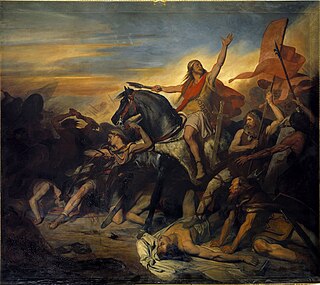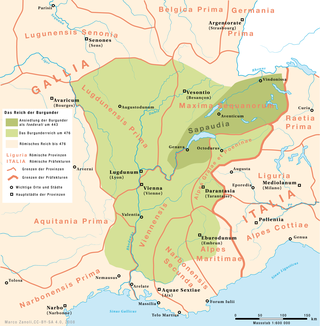
The Burgundians were an early Germanic tribe or group of tribes. They appeared east in the middle Rhine region in the third century AD, and were later moved west into the Roman Empire, in Gaul. In the first and second centuries AD they, or a people with the same name, were mentioned by Roman writers living west of the Vistula river in the region of Germania which is now part of Poland.
The 500s decade ran from January 1, 500, to December 31, 509.

Year 501 (DI) was a common year starting on Monday of the Julian calendar. At the time, it was known as the Year of the Consulship of Avienus and Pompeius. The denomination 501 for this year has been used since the early medieval period, when the Anno Domini calendar era became the prevalent method in Europe for naming years.

Clovis was the first king of the Franks to unite all of the Franks under one ruler, changing the form of leadership from a group of petty kings to rule by a single king, and ensuring that the kingship was passed down to his heirs. He is considered to have been the founder of the Merovingian dynasty, which ruled the Frankish kingdom for the next two centuries. Clovis is important in the historiography of France as "the first king of what would become France."

Clotilde, is a saint and was a Queen of the Franks.

Chlothar I, sometime called "the Old", also anglicised as Clotaire, was a king of the Franks of the Merovingian dynasty and one of the four sons of Clovis I.

The Battle of Tolbiac was fought between the Franks, who were fighting under Clovis I, and the Alamanni, whose leader is not known. The date of the battle has traditionally been given as 496, though other accounts suggest it may either have been fought earlier, in the 480s or early 490s, or later, in 506. The site of "Tolbiac", or "Tolbiacum", is usually given as Zülpich, North Rhine-Westphalia, about 60 km east of what is now the German-Belgian frontier. The Franks were successful at Tolbiac and established their dominance over the Alamanni.

Gundobad was King of the Burgundians (473–516), succeeding his father Gundioc of Burgundy. Previous to this, he had been a patrician of the moribund Western Roman Empire in 472–473, three years before its collapse, succeeding his uncle Ricimer. He is perhaps best known today as the probable issuer of the Lex Burgundionum legal codes, which synthesized Roman law with ancient Germanic customs. He was the husband of Caretene.

Sigismund was King of the Burgundians from 516 until his death. He was the son of king Gundobad and Caretene. He succeeded his father in 516. Sigismund and his brother Godomar were defeated in battle by Clovis's sons, and Godomar fled. Sigismund was captured by Chlodomer, King of Orléans, where he was kept as a prisoner. Later he, his wife and his children were executed. Godomar then rallied the Burgundian army and won back his kingdom.

Chlodomer, also spelled Clodomir or Clodomer was the second of the four sons of Clovis I, King of the Franks.
Kingdom of Burgundy was a name given to various states located in Western Europe during the Middle Ages. The historical Burgundy correlates with the border area of France and Switzerland and includes the major modern cities of Geneva and Lyon.
Godomar II, son of king Gundobad, was king of Burgundy. He ruled Burgundy after the death of Sigismund, his elder brother, in 524 until 534.
Chilperic II was the King of Burgundy from 473 until his death. Before that he co-ruled with his father Gondioc beginning in 463. He began his reign in 473 after the partition of Burgundy with his younger brothers Godegisel, Gundobad, and Godomar; he ruled from Valentia Julia (Valence) and his brothers ruled respectively from Geneva, Vienne, and Lyon.

The Kingdom of the Burgundians, or First Kingdom of Burgundy, was established by Germanic Burgundians in the Rhineland and then in eastern Gaul in the 5th century.
Godomar I was a son of the Burgundian king Gondioc, and a brother of Godegisel, Chilperic II and Gundobad. After the death of Gondioc and his brother Chilperic I, the four sons of Gondioc are said to have ruled Burgundy together from different parts of the kingdom. This is doubted by modern scholars due to lack of evidence. It is now believed that both Godomar and Chilperic had died before 476/477, and that only Godegisel and Gundobad shared the rule.
Suavegotha, also known as Suavegotta or Suavegotho, was the daughter of the Burgundian king Sigismund and his Ostrogothic wife Ostrogotho. She was apparently married to Theuderic I, but scholars debate whether she was his first or second wife.

The Franco-Visigothic Wars were a series of wars between the Franks and the Visigoths, but it also involved the Burgundians, the Ostrogoths and the Romans. The most noteworthy war of the conflict would be the Second Franco-Visigothic War that included the famous Battle of Vouillé and resulted in Frankish annexation of most of Southern France.
Teudelinda was a Burgundian queen consort by marriage to king Godegisel. She founded a number of churches around Geneva. Teudelinda was killed at Vienne during the war between her husband and his brother, Gundobad.
The siege of Arles between 507 and 508 was a battle between the Franks and Burgundians, who wanted to occupy Provence, and the Visigothic Kingdom, who had the support of the Ostrogothic Kingdom.










